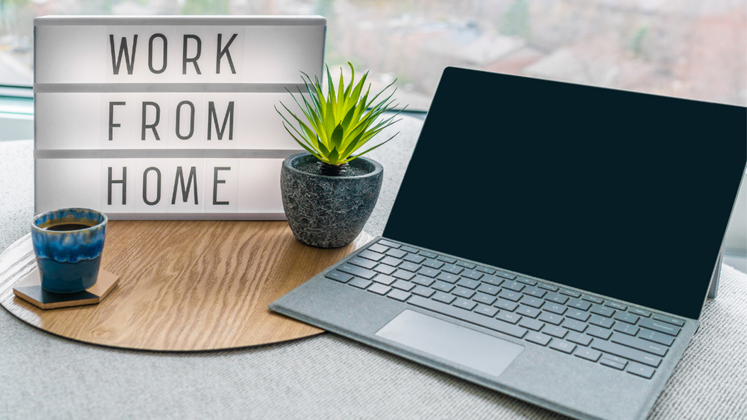The concept of ‘Work-From-Home’ (WFH), is not really new, but the spread and penetration has grown immensely during the corona crisis. Before 2019, remote work was meant to be implemented by corporates in departments like marketing, admin, customer service, etc., and that too mostly for people who needed support like women with young children or others with health issues. In sectors like distribution, real estate or manufacturing, the scope for flexibility of working from home was practically unheard of. But with the ‘New Normal’, even manufacturers have successfully explored this new scenario.
To the surprise of many, WFH has proved to be a viable option for apparel manufacturing industry, but is still limited to few processes and operations in its supply chain. The biggest positive is that, even after one-and-a-half years of COVID-19, the companies in the apparel industry are reviewing what can be done from remote locations in long-run. As other industries take their working process to a hybrid model, allowing certain work to continue from home, there are obvious factory jobs that can’t be done under WFH model in apparel manufacturing business and have to be strictly conducted from office/factory premises.
According to a survey by ManageEngine, around 95 per cent of Indian companies are planning to stick to remote working for the next two years at least. A report of Forbes, 20 per cent to 30 per cent new jobs can shift permanently into WFH and after 5G technology, this figure can go up by 30 per cent to 40 per cent also. Overall, IT professionals, accountants, Business Development, HR and Data Analysts are the job profiles which majorly will continue with WFH.
There is no doubt that being labour-intensive and totally different than IT and other industries, the working of the apparel industry is very unique with very different needs. In fact, there are very few apparel manufacturers in India that have Saturday off for their staff. Also, the systems of monitoring work, are currently not equipped to properly monitor and monetise WFH. The industry is more comfortable in face-to-face communication with its employees.
However, looking at a broader perspective, departments like Marketing Merchandising, Design, Accounts and HR are operations that do not require daily interaction. And many companies accept that during lockdown, people handling these operations have been even more productive. Expressing the opinion of many manufacturers, HS Jha, VP-HR, Pratibha Syntex, Indore shares, “During the lockdown, we have noticed that professionals of departments like HR, Finance have been more productive when they were working from home. Especially their decision making was fast, reply on mails were done in no time. Normally in office, they indulge in many things while during the WFH period, they were more focused.” He further adds that in the next few years, we can see a major change in the scenario. Interestingly, buying office Triburg has a one-day WFH or factory policy from last one decade.
Now that the offices and factories are open, the industry has shifted to a more hybrid approach towards managing their office work: introducing a roster-based system where job location fluctuates between factories, homes and offices. And there are clearly benefits out of it, flexibility in working being on top.
Also Read: Retailers and brands’ focused areas in sustainability
Departments that could WFH with support from Technology
- Design and Development– What was unusual not so long ago, now is part of the working normality in the fashion industry. And the designers have seen a complete transformation in their way of working during COVID-19 times. The use of 3D sampling is now increasing in the factories which were quite reluctant in letting physical sampling go previously. The disruption that COVID-19 has brought in the manufacturing business with all restrictions on travelling and social distancing norms is pushing factories to opt for digitalisation wherever possible. And, most importantly, these 3D sampling can be done by a designer sitting at home using softwares like CLO3D, Browzwear, Tukatech, Lectra, Gerberamong others. The pattern makers can also generate patterns in different sizes while they work from home on Tukatech’s APM that’s world’s first Automatic Pattern Maker for which they needn’t go to factories. The companies can move from local system to cloud system in order to have flexibility to work from anywhere.
- Handling garments, QC audits and approving samples – The product development and quality departments were among the first ones that opted for hybrid working process and set up virtual QC studios. The head office may act as a postal hub for sending and receiving the garments between factory merchandisers and buyers but all the approval thing can still be managed from remote location. BlueKaktus-QCis a software tool, offered by Royal Datamatics, which follows the same mantra as there is an unprecedented demand predicted for virtual quality inspection in apparel factories. The tool supports this virtual inspection by digitising the process with Digital Quality module where vendors can perform their Quality Processes/Audits on a single platform which can be accessed by the clothing brands online.
While a quality person or a merchandiser is sitting at home for whatever reason, a complete digital record of inspection images, videos and defects that are maintained digitally with the cloud-based tool for all stakeholders to review helps them participate actively in the entire process. “Digitisation can still help people manage things from home. BlueKaktus does support uploading videos that a person from merchandising or from quality can view from home to see what is going on in factory in real-time, and can help in approval process and decision making process,” comments Gunish Jain, CEO, BlueKaktus.
- Documentation printing and labelling– Due to sensitivities and confidentialities, many items/documents cannot be sent to the merchandisers’ houses. However, many companies have opted for a roster-based office work to support those merchandisers who can’t join offices or factories and are working from remote locations. Bangladesh’s SQ Group is one of such companies that eased work for its employees during COVID-19 with this roster-based work.
- Buyer Communication and Meetings– These can be done with a mixture of in-person and virtual meetings. Virtual meetings have gained a lot of attraction in last one-and-a-half years and are still continuing. Not only has international travel shifted to virtual meets, but the domestic meetings have also gone virtual that can be conducted by marketing persons even if they are staying in their homes. As far as longevity of WFH model in marketing department is concerned, it’s possible in long-run, however it is a matter of comfort of the management, adjustment to the new systems and how the management team wants to do their business. It is COMPLETELY okay if the company keeps meeting their KPIs and targets through WFH models.
- HR Management– An effective HR Department has multiple operational sectors such as corporate social responsibility, stakeholder management, administrative, legal compliance, payroll management, welfare among many others.
With the advent of different payroll management systems that are integrated to new-age ERPs, all these jobs have become easier to manage and, as the data and information remain on cloud, an HR can manage most of these activities sitting at home. The tools like Qandle are helping make HR teams across industries more advanced. Apart from this, even hiring in offices and factories (from top to mid-level employees) can be done through virtual meets and it is happening.
“While everyone may be discussing technology for enabling WFH, it requires some fundamental change of mindsets and habits from both employers and employees,” says Dr Prabir Jana, Shahi Chair Professor, Industry 4.0 at NIFT sharing some insightful changes that are a must for successful implementation of WFH model.
Keeping anyone busy is not necessarily productive: Those aware about theory of constraints (ToC) concept will appreciate this mindset. WFH loses the crucial control to keep the subordinates busy, hence the resistance from management.
Visual or physical presence is not necessarily effective supervision: Indian work culture (starts with education system) begins with supervisory control. Everyone wants to be supervised (may be hangover from colonial system). Unless the subordinate is physically present (or visually present during Covid time) the superior does not feel comfortable.
The habit of asking rather than observing or reading, is a constraint: We Indians prefer to ask rather than reading guidelines (if available) or observe to gain information. Self-learning (which is completely missing) requires frequent interaction between superiors and subordinates and thus physical presence makes things easier.
Last, but not the least, detachment with ‘my space’: We all have an ‘individual workspace’ at the workplace, be it a cabin, a table/chair or a computer desk and are emotionally attached to it. We need to give up that. To practice WFH sustainably, the management has to reduce the workspace to employee ratio (which is practised by many IT majors already). Imagine the way sewing operators work, they don’t sit on any particular sewing machine every day, once they punch their attendance, they are allocated a sewing machine based on style/production requirement and attendance on that day.
If the management and employee can get over the above mindsets and habits, WFH will be easier, productive and sustainable.







